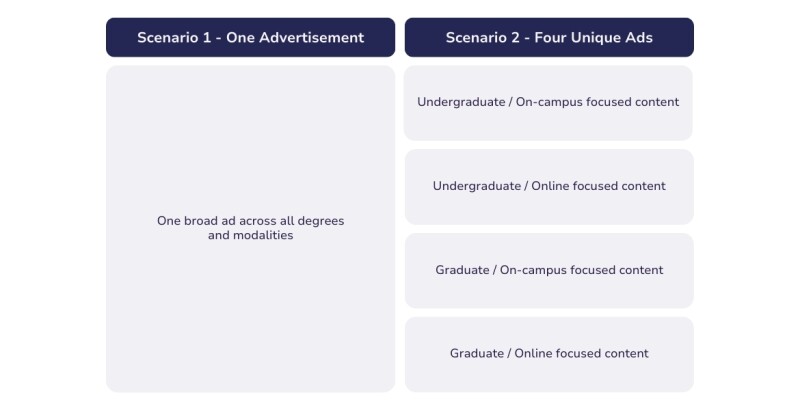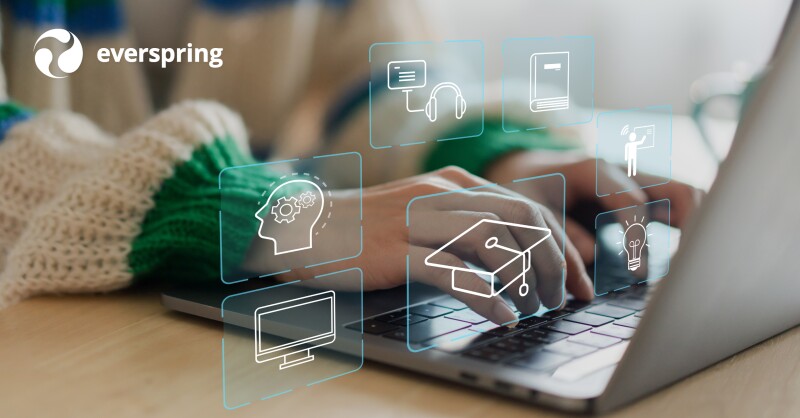Higher education enrollment marketing is evolving at a rapid pace. The days of presenting students with a catalog of offerings and waiting for them to enroll are over. Instead, colleges and universities need a tailored approach to communication that guides students through their decision-making and enrollment process. A customized, data-driven approach to the student journey can reduce acquisition costs by half—serving as a proven difference maker.¹
Personalized marketing isn't a luxury—it's a must-have for driving enrollment growth effectively. In a noisy world, using data-driven personalized marketing is like cutting through the clutter to connect directly with your audience's thoughts and feelings.

Personalization in marketing refers to placing tailored messaging, based on individualized data, in front of your prospects. It allows marketers to hone their messaging to what the prospect cares about instead of placing broad messaging in front of the entirety of the target market. This leads to higher engagement because the messaging the prospect sees in an ad, an email, or on your website resonates with their interests and objectives. Audience segmentation is fundamental to an effective personalization strategy.
Higher Education Segmentation and Personalization in Action
Imagine a business school that offers both undergraduate and graduate degrees via on-campus or online modalities. The business school has lead data inclusive of degree level and preferred modality. They plan to target their leads on social media with a 15-second video that includes a call to action to speak with an advisor. If they choose to run one ad, they must keep messaging and imagery general across degrees and modalities, potentially repeating information the prospect has seen. On the other hand, if they create four unique ads, they can maximize the 15 seconds by providing relevant information specific to each segment (e.g., course length, SAT/GMAT info, online flexibility, on-campus lifestyle, etc.).

The second scenario will be more engaging, drive longer video views, and garner many more advisor conversations, as 97% of marketers report a measurable lift from personalization efforts.²
The above example is simplified to one channel, four data points, and one interaction. However, a real-world enrollment journey can be months long and involves many touchpoints across multiple channels. Candidate interactions will happen on your website, social media platforms, emails, during conversations with advisors, and through other mediums. A robust strategy will use personalized messaging across channels while also capturing new data from each interaction the prospect has with your university. The objective is to use personalization to guide prospective students through the enrollment process, effectively nudging them to the next step towards enrollment.
Boost Student Engagement with a Personalized Marketing Strategy
Data is the glue that holds personalized marketing together. The data should be stored in a customer data platform that is integrated with your website, paid media campaigns, and email marketing efforts. A comprehensive digital marketing strategy is vital to managing these multiple touchpoints, ensuring a cohesive and personalized experience for the prospective student. Personalized marketing allows you to lead a consistent enrollment journey across the channels the prospect prefers. An underlying recommendation throughout your personalization strategy is to consistently show empathy for the weight of the decision the prospective student must make, demonstrating an understanding of the expense and time involved.
Initially, your strategy should include personalized email and paid media retargeting efforts that drive students to segment-specific landing pages. Features that can be added as your strategy matures are chatbots, dynamic website content, and text messaging. These features and most aspects of your personalization strategy can be integrated with AI-driven content for efficiency and scale.
Using Personalized Strategies to Lower Lead Acquisition Costs
Leveraging data to tailor your marketing is a powerful way to lower lead acquisition costs. Personalization in marketing helps create meaningful connections with your audience, leading to increased engagement, improved conversion rates, and optimized resource allocation. This improves the overall efficiency of your marketing efforts. For example:
- By improving the accuracy of your audience segmentation and targeting, you can optimize spend and achieve a better ROI, lowering the cost of acquiring qualified leads.
- With tailored communications and content, your marketing is more likely to capture prospects’ interest and engage them, leading to higher conversion rates and ultimately lowering cost per lead.
- With continued analysis, you can identify patterns in audience behavior and adjust your marketing strategy accordingly. This optimization allows you to allocate resources more efficiently, lowering lead acquisition costs over time.
Balancing Personalization with Privacy Concerns
Be subtle yet deliberate in your personalization efforts. While prospective students are accustomed to data-driven, personalized marketing interactions, it’s important to avoid giving them any reason to be concerned about sharing their data with you. Do not personalize excessively; it can disengage prospects. It’s also important to be transparent about how you are collecting and using personal data, both for ethical and legal reasons.
The technologies that empower personalization are dynamic. Understanding how to collect, store, and use the data to drive personalization can be overwhelming. Furthermore, prioritizing the channels and technologies for implementing personalization strategies while staying within budget requires a balancing act. Please contact Everspring to learn more about how our team of experts can help evolve your marketing efforts.
1. McKinsey, Marketing’s Holy Grail: Digital Personalization at Scale
2. Salesforce, 2020 Trends in Personalization

